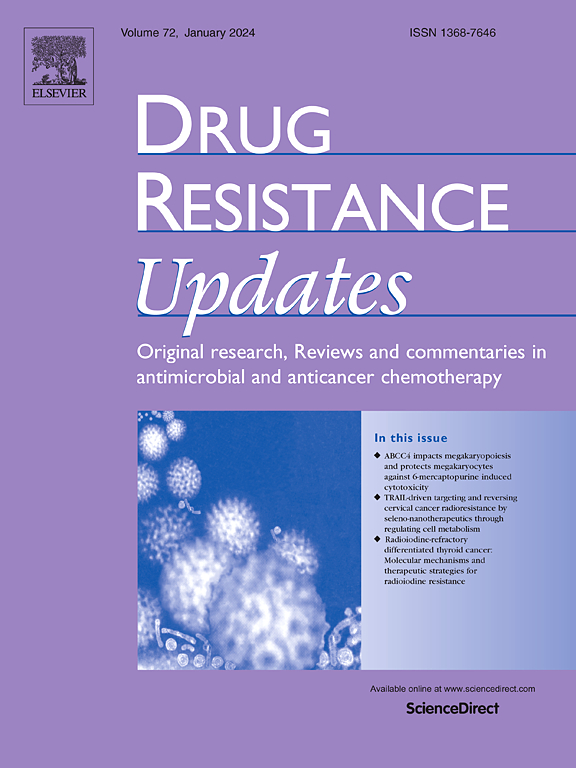Dissection of immunotherapeutic predictive versus prognostic transcriptional programs identifies SLC22A5-centric carnitine metabolism-driven resistance to anti-PD-(L)1 treatment in non-small cell lung cancer
IF 21.7
1区 医学
Q1 PHARMACOLOGY & PHARMACY
引用次数: 0
Abstract
Aims
Prognostic and predictive biomarkers are two common biomarker types in clinics, with the former indicating the natural course of cancer regardless of treatment, and the latter determining the response to a specific regimen. Understanding the predictive versus prognostic effect of biomarkers is essential to understand treatment-specific response from the inherent prognosis of cancer. Herein, we aimed to uncover the predictive metabolic signatures specific to immunotherapy resistance by distinguishing the predictive versus prognostic effect of transcriptional programs in advanced non-small cell lung cancer (NSCLC) treated with immunotherapy.
Methods
Clinical and transcriptomic data were collected from two randomized controlled trials, OAK (n = 699, discovery cohort) and POPLAR (n = 192, validation cohort) comparing immunotherapy with chemotherapy. Metabolic transcriptional signature scores were calculated through gene set variation analysis. Cox regression and interaction test were conducted to differentiate the predictive versus prognostic effect. Additionally, lung tumor-bearing murine models were established using Slc22a5-overexpressing (OE) and control Lewis Lung Carcinoma (LLC) cells, and treated with immunotherapy or chemotherapy. The translational potential of an SLC22A5 (Solute Carrier Family 22 Member 5) inhibitor in combination with immunotherapy was assessed in preclinical setting. The tumor microenvironment was analyzed by flow cytometry, immunofluorescence, and Enzyme-Linked Immunosorbent Assay (ELISA) to validate the mechanistic findings.
Results
Metabolic transcriptional programs were divided into four categories based on different predictive effects specific to immunotherapy or chemotherapy, among which carnitine metabolism stood out as the most prominent metabolic process contributing to the resistance to immunotherapy. Specifically, SLC22A5 as the only high-affinity carnitine transporter was remarkably upregulated in immunotherapy-resistant patients. The predictive effect of SLC22A5-centric carnitine metabolism for resistance to immunotherapy rather than chemotherapy was independently validated in an external randomized trial. Critically, preclinical models revealed that Slc22a5 overexpression drove resistance to immunotherapy but not chemotherapy, by fostering an immunosuppressive microenvironment characterized by M2 macrophage accumulation and CD8 + T cell exclusion. Furthermore, pharmacological inhibition of SLC22A5 by meldonium reshaped the tumor microenvironment toward a more inflamed state and re-sensitized resistant tumors to immunotherapy.
Conclusions
Our study elucidates the predictive versus prognostic effect of metabolic pathways in advanced NSCLC under immunotherapy. Tumor-intrinsic carnitine metabolism may predict and drive immunotherapy resistance, and targeting SLC22A5-mediated carnitine metabolism could be used to overcome resistance in advanced NSCLC.
解剖免疫治疗预测与预后转录程序确定slc22a5为中心的肉毒碱代谢驱动的抗pd -(L)1治疗在非小细胞肺癌的耐药
预后生物标志物和预测性生物标志物是临床中两种常见的生物标志物类型,前者指示癌症的自然进程,而不考虑治疗,后者决定对特定方案的反应。了解生物标志物的预测与预后作用对于了解癌症固有预后的治疗特异性反应至关重要。在此,我们旨在通过区分转录程序在接受免疫治疗的晚期非小细胞肺癌(NSCLC)中的预测作用和预后作用,揭示免疫治疗耐药特异性的预测性代谢特征。方法收集两项随机对照试验OAK (n = 699,发现队列)和POPLAR (n = 192,验证队列)的临床和转录组学数据,比较免疫治疗和化疗。通过基因集变异分析计算代谢转录特征评分。采用Cox回归和交互作用检验来区分预测效应和预后效应。此外,使用slc22a5过表达(OE)和对照Lewis肺癌(LLC)细胞建立肺荷瘤小鼠模型,并进行免疫治疗或化疗。SLC22A5(溶质载体家族22成员5)抑制剂联合免疫治疗的转化潜力在临床前环境中进行了评估。通过流式细胞术、免疫荧光和酶联免疫吸附试验(ELISA)分析肿瘤微环境以验证机制发现。结果根据对免疫治疗或化疗的不同预测作用,将代谢转录程序分为四类,其中肉碱代谢是导致免疫治疗耐药的最突出的代谢过程。具体来说,SLC22A5作为唯一的高亲和力肉毒碱转运蛋白在免疫治疗耐药患者中显著上调。在一项外部随机试验中,slc22a5中心肉毒碱代谢对免疫治疗而非化疗耐药的预测作用得到了独立验证。重要的是,临床前模型显示,Slc22a5过表达通过培养以M2巨噬细胞积累和CD8 + T细胞排斥为特征的免疫抑制微环境,驱动免疫治疗耐药,而不是化疗耐药。此外,米屈肼对SLC22A5的药理学抑制重塑了肿瘤微环境,使其朝着更加炎症的状态发展,并使耐药肿瘤对免疫治疗重新敏感。结论sour研究阐明了免疫治疗晚期非小细胞肺癌中代谢途径的预测作用和预后作用。肿瘤内生性肉毒碱代谢可预测和驱动免疫治疗耐药,靶向slc22a5介导的肉毒碱代谢可用于克服晚期NSCLC的耐药。
本文章由计算机程序翻译,如有差异,请以英文原文为准。
求助全文
约1分钟内获得全文
求助全文
来源期刊

Drug Resistance Updates
医学-药学
CiteScore
26.20
自引率
11.90%
发文量
32
审稿时长
29 days
期刊介绍:
Drug Resistance Updates serves as a platform for publishing original research, commentary, and expert reviews on significant advancements in drug resistance related to infectious diseases and cancer. It encompasses diverse disciplines such as molecular biology, biochemistry, cell biology, pharmacology, microbiology, preclinical therapeutics, oncology, and clinical medicine. The journal addresses both basic research and clinical aspects of drug resistance, providing insights into novel drugs and strategies to overcome resistance. Original research articles are welcomed, and review articles are authored by leaders in the field by invitation.
Articles are written by leaders in the field, in response to an invitation from the Editors, and are peer-reviewed prior to publication. Articles are clear, readable, and up-to-date, suitable for a multidisciplinary readership and include schematic diagrams and other illustrations conveying the major points of the article. The goal is to highlight recent areas of growth and put them in perspective.
*Expert reviews in clinical and basic drug resistance research in oncology and infectious disease
*Describes emerging technologies and therapies, particularly those that overcome drug resistance
*Emphasises common themes in microbial and cancer research
 求助内容:
求助内容: 应助结果提醒方式:
应助结果提醒方式:


